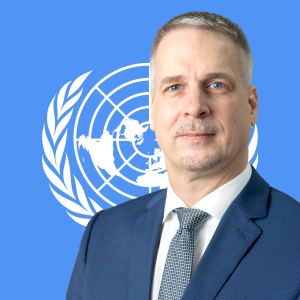It is my pleasure to speak at the occasion of the capacity building programme, focused on the implementation of the Jaipur Declaration on 3R and Circular Economy 2025–2035 in conjunction with the Consultation on the New Cleaner Pacific 2036 Regional Waste and Pollution Management Strategy.
Let me begin by thanking the Secretariat of the Pacific Regional Environment Programme (SPREP), the Ministry of Environment and Climate Change of Fiji and the UN Centre for Regional Development (UNCRD) and all supporting partners for organizing this capacity building programme. I also thank our previous speakers for their insightful remarks. You have set the stage with powerful messages about the urgency of ending plastic pollution, the importance of regional collaboration for the circular economy, and the need to rethink how we manage our waste and resources.
In the Pacific region, waste is not just a challenge, it is a crisis. And it is not one-dimensional. Waste is diverse, complex, deeply embedded in every facet of life – and waste is crosscutting across all sectors.
Today, I want to speak from a place of both urgency and experience. As you all are aware, the Pacific Countries and Territories are among the most disaster-prone nations in the world, with frequent cyclones, other climate-related hazards, earthquakes, volcanic activity and tsunamis.
In December last year, I was in Vanuatu shortly after the devastating earthquake that struck on the 17th. What I saw there was heartbreaking, but also deeply revealing. The earthquake did not just shake buildings. It shook the very systems meant to protect people and the environment. Waste, suddenly and overwhelmingly, became a public health emergency. Rubble and toxic debris from collapsed and structurally damaged buildings, some containing asbestos, piled up. Ecosystems were at risk of oil and sewage spills. The primary landfill, already nearing capacity before the disaster, was pushed to its limits. This was a stark reminder of how fragile and under-resourced our waste and pollution management systems are, especially in the face of shocks.
And this is why we need to look at waste from every possible angle and why the Circular Economy is not just a concept, but a necessity. The Jaipur Declaration on 3R and Circular Economy (2025-2035) offers a bold and forward-looking vision for contributing to the achievement of the Sustainable Development Goals.
It calls on us to move beyond linear models of consumption and disposal, and toward systems that are regenerative by design, where materials are kept in use, waste is minimized and eventually completely designed out of consumption and production systems, and natural ecosystems are protected and restored.
The Cleaner Pacific 2025 Strategy (2016-2025) laid the groundwork for this transformation in our region. It emphasized integrated approaches to waste and pollution management and strengthened governance. As we now look toward the New Cleaner Pacific 2036 Regional Waste and Pollution Management Strategy, we must build on that foundation with even greater ambition and cooperation between governments at all levels, regional organizations, CSOs, NGOs, academia and the United Nations. Crosscutting challenges demand cross-cutting solutions, joined-up thinking for joined-up action.
As we turn our focus to the circular economy and the 3Rs, we must also consider the global context. Leaders at the Third United Nations Ocean Conference called for an international legally binding instrument to end plastic pollution, including in the marine environment. The Pacific has been a strong and united voice in these negotiations, and rightly so. Our region is on the frontlines of plastic pollution, and we must ensure that the treaty reflects the realities and needs of Small Island Developing States. Central to this, and all our efforts, is the promotion of the 3Rs: Reduce, Reuse, and Recycle, as foundational principles for both national action and global cooperation. These principles are not only practical tools for waste minimization, but also essential pillars of the circular economy and key to achieving the treaty’s long-term goals
Distinguished participants, our Pacific Island Countries and Territories face unique constraints due to their high import dependency, high cost of operations, limited land, and a lack of domestic recycling infrastructure among others. But here is the opportunity: Pacific SIDS can be global leaders in circular innovation. By rethinking waste, not as a burden, but as a resource, we can build resilient, regenerative systems that protect both people and planet.
Now is the time to think beyond the conventional, to pursue bold, forward-looking solutions to a problem we can no longer afford to ignore. I invite you to reflect on the following question as we begin today’s consultation:
If your great-grandchildren looked back at how we manage resources and waste today, what would they say?
Would they see a region overwhelmed by waste, or one that turned crisis into innovation?
Let’s make sure it is the latter.
Vinaka Vakalevu, Dhanjavaad, Thank You
[END]




